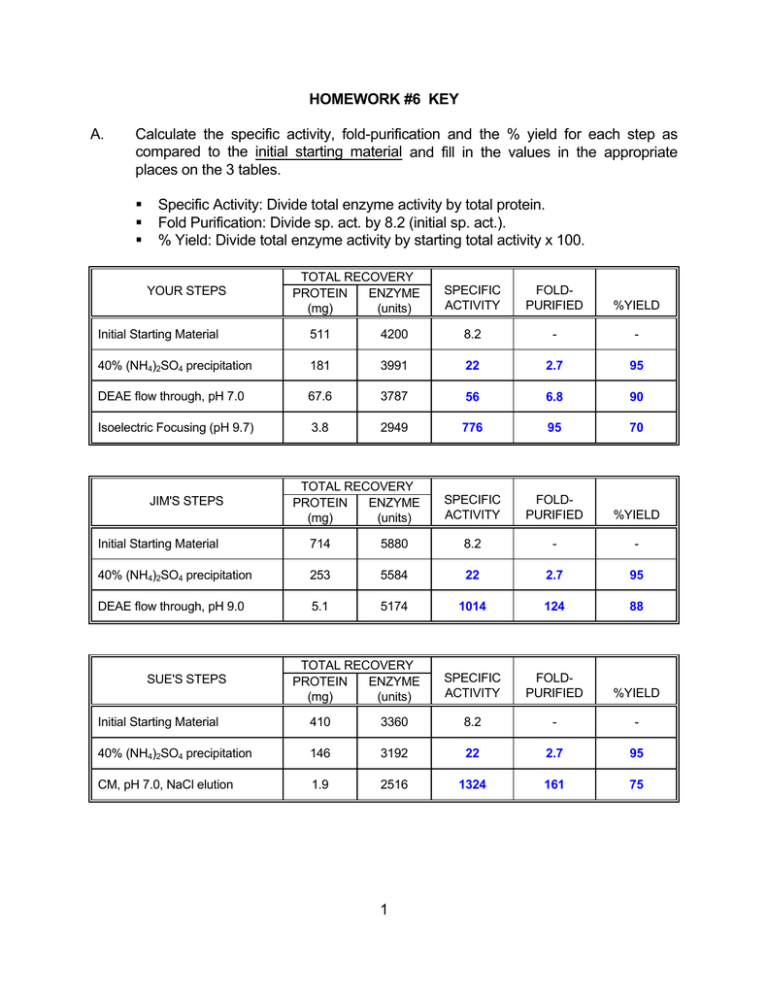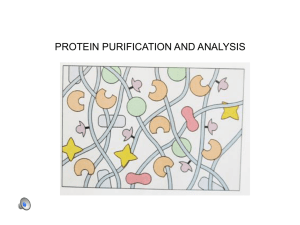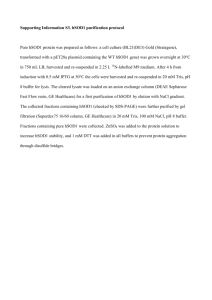A. Calculate the specific activity, fold-purification and the % yield for... compared to the initial starting material and fill in the...
advertisement

HOMEWORK #6 KEY A. Calculate the specific activity, fold-purification and the % yield for each step as compared to the initial starting material and fill in the values in the appropriate places on the 3 tables. Specific Activity: Divide total enzyme activity by total protein. Fold Purification: Divide sp. act. by 8.2 (initial sp. act.). % Yield: Divide total enzyme activity by starting total activity x 100. YOUR STEPS TOTAL RECOVERY PROTEIN ENZYME (mg) (units) SPECIFIC ACTIVITY FOLDPURIFIED %YIELD Initial Starting Material 511 4200 8.2 - - 40% (NH4)2SO4 precipitation 181 3991 22 2.7 95 DEAE flow through, pH 7.0 67.6 3787 56 6.8 90 Isoelectric Focusing (pH 9.7) 3.8 2949 776 95 70 SPECIFIC ACTIVITY FOLDPURIFIED %YIELD JIM'S STEPS TOTAL RECOVERY PROTEIN ENZYME (mg) (units) Initial Starting Material 714 5880 8.2 - - 40% (NH4)2SO4 precipitation 253 5584 22 2.7 95 DEAE flow through, pH 9.0 5.1 5174 1014 124 88 SPECIFIC ACTIVITY FOLDPURIFIED %YIELD SUE'S STEPS TOTAL RECOVERY PROTEIN ENZYME (mg) (units) Initial Starting Material 410 3360 8.2 - - 40% (NH4)2SO4 precipitation 146 3192 22 2.7 95 CM, pH 7.0, NaCl elution 1.9 2516 1324 161 75 1 B. After swallowing your pride you realize your friends have improved upon your method. What factors would you consider in choosing between Sue or Jim's protocol. C. What information in your purification scheme prompted Sue to switch to cation exchange chromatography? D. The isoelectric point of 9.7. Generally do cation exchange below the isoelectric point. Also the failure to bind to an anion exchange column suggested that a cation exchanger might bind the protein. Why did switching the pH from 7.0 to 9.0 result in a better fold-purification at the DEAE chromatography step? E. Sue and Jim's protocols both have less steps, a better yield and better fold purification than yours. Jim had a slightly better yield than Sue, but Sue had a slightly better foldpurification. Choosing between them would depend on whether quality or quantity were more important. Other factors to consider would be whether pH 9 (Jim's) or the NaCl (Sue's) would be detrimental for the subsequent use of the protein. Raising the pH resulted in more contaminating proteins becoming negatively charged and therefore binding to the DEAE. In other words, proteins with isoelectric points between 7-9 would now absorb to the DEAE column If your protein is approximately 0.1% of the initial starting material, what percentage of the total protein in your last purification step is probably your protein. In other words, how pure is your protein? How could you assess this? The approximately 100-fold purification means that approximately 10% of the protein in the final step is your protein. To be more quantitative, multiply the initial percentage by the fold-purification (0.1 x 95 = 9.5%) Alternatively, approximately 0.5 mg of the starting material is your protein and with a 70% yield approximately 0.35 mg of the 3.8 mg is your protein (0.35/3.8 x 100 = 9.2%). the relative purity can be assessed by gel electrophoresis 2






